Analysis of Nanotechnology Applications in the Packaging Industry
VerifiedAdded on 2019/12/03
|50
|19529
|38
Report
AI Summary
This report provides an in-depth analysis of nanotechnology's applications in the food packaging industry. It explores various aspects, including the definition of nanotechnology, its rapid growth, and the advantages it offers, such as reduced food wastage, enhanced food safety, and extended shelf life. The report delves into specific applications like nanolaminates, nanocoatings, and nanosensors, highlighting their role in indicating food freshness and improving convenience for consumers. However, it also acknowledges the potential risks associated with nanotechnology, such as the leaching of nanoparticles into food and consumer concerns regarding health and environmental impacts. The report emphasizes the need for appropriate regulations to manage nanotechnology effectively in food packaging, ensuring consumer acceptance and safety. The methodology involved secondary data collection, including electronic searches and database references. The report also touches on the role of biotechnology and intelligent packaging, which further enhances the food packaging landscape. Overall, the report provides a comprehensive overview of the current state and future prospects of nanotechnology in food packaging, considering both its benefits and challenges.
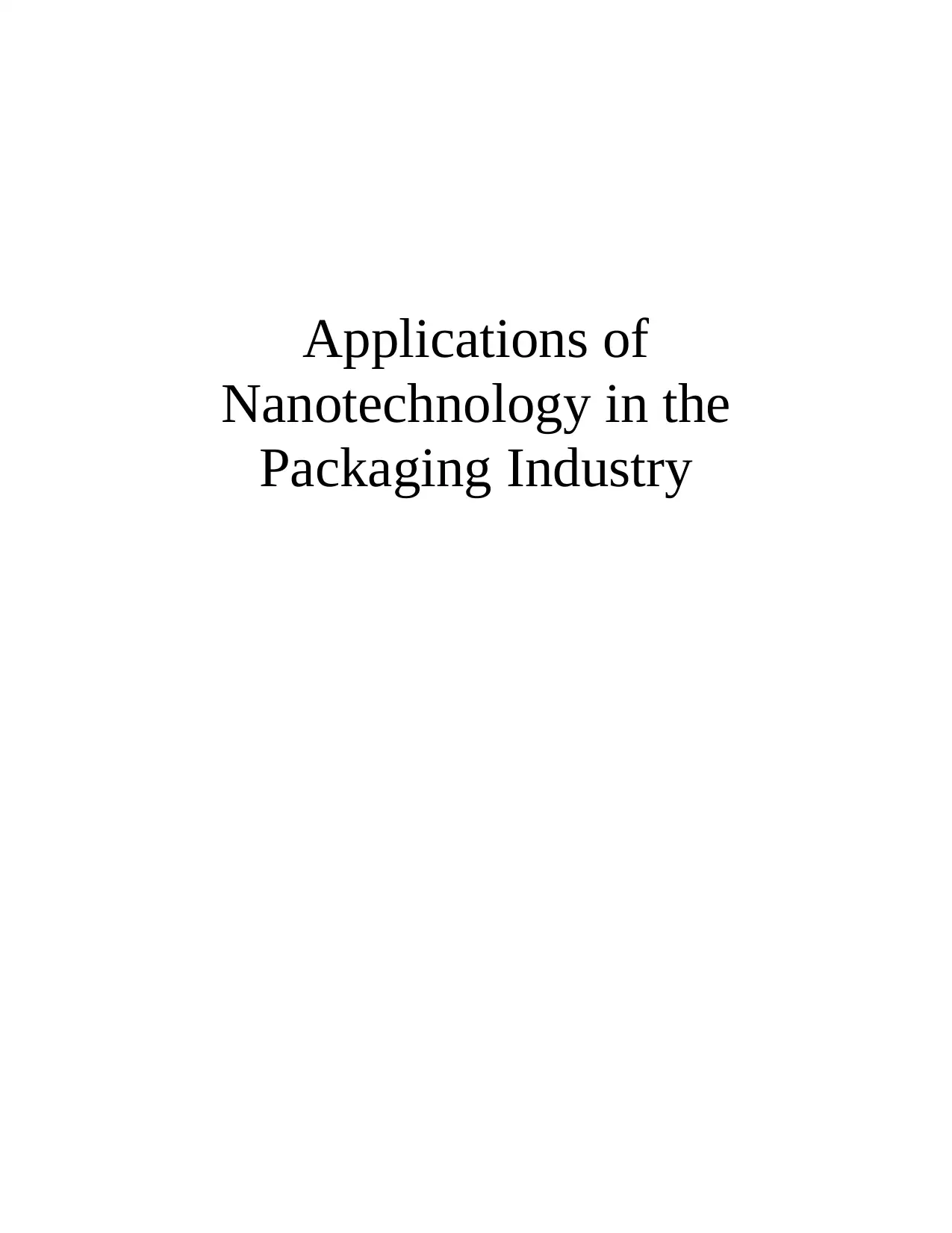
Applications of
Nanotechnology in the
Packaging Industry
Nanotechnology in the
Packaging Industry
Paraphrase This Document
Need a fresh take? Get an instant paraphrase of this document with our AI Paraphraser
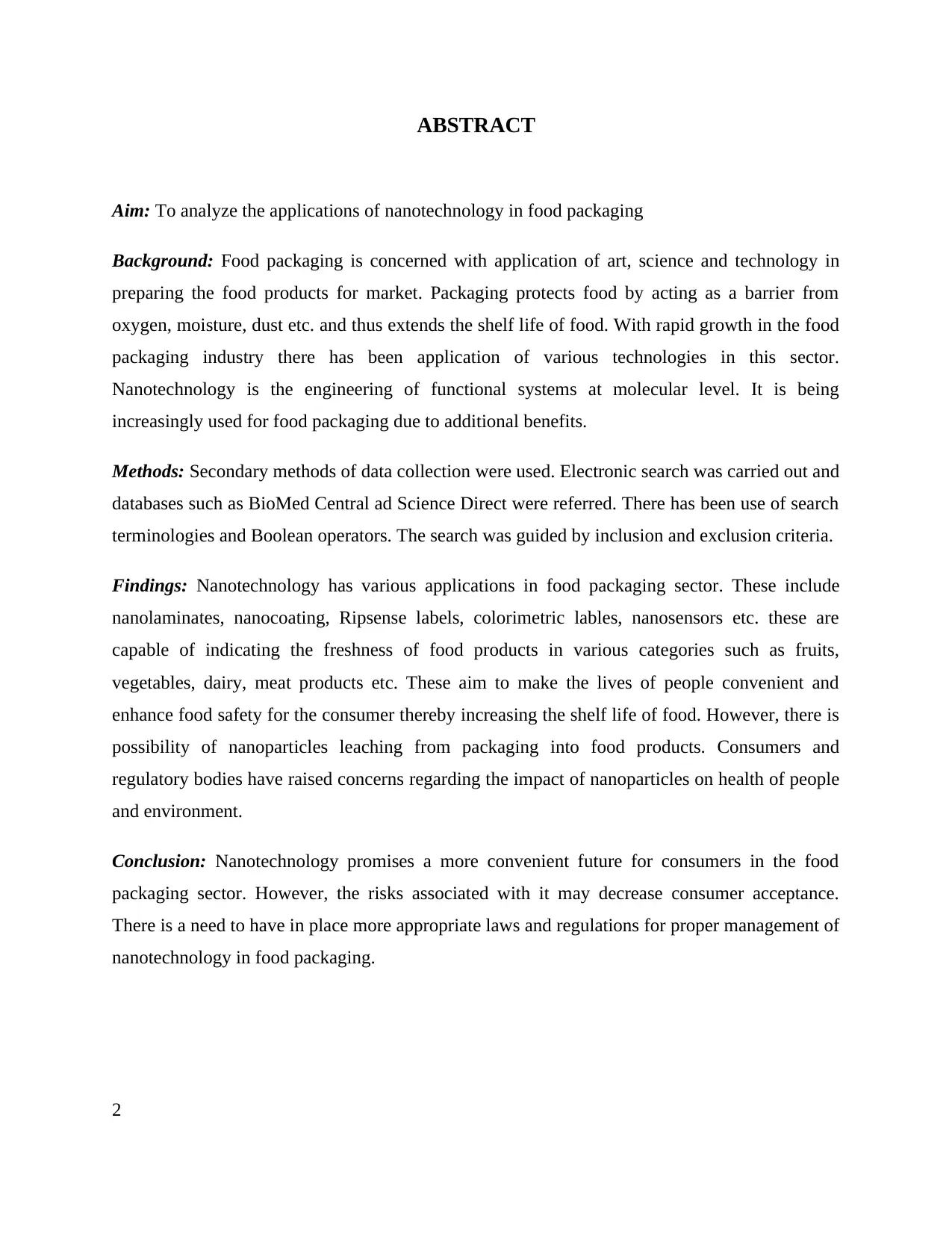
ABSTRACT
Aim: To analyze the applications of nanotechnology in food packaging
Background: Food packaging is concerned with application of art, science and technology in
preparing the food products for market. Packaging protects food by acting as a barrier from
oxygen, moisture, dust etc. and thus extends the shelf life of food. With rapid growth in the food
packaging industry there has been application of various technologies in this sector.
Nanotechnology is the engineering of functional systems at molecular level. It is being
increasingly used for food packaging due to additional benefits.
Methods: Secondary methods of data collection were used. Electronic search was carried out and
databases such as BioMed Central ad Science Direct were referred. There has been use of search
terminologies and Boolean operators. The search was guided by inclusion and exclusion criteria.
Findings: Nanotechnology has various applications in food packaging sector. These include
nanolaminates, nanocoating, Ripsense labels, colorimetric lables, nanosensors etc. these are
capable of indicating the freshness of food products in various categories such as fruits,
vegetables, dairy, meat products etc. These aim to make the lives of people convenient and
enhance food safety for the consumer thereby increasing the shelf life of food. However, there is
possibility of nanoparticles leaching from packaging into food products. Consumers and
regulatory bodies have raised concerns regarding the impact of nanoparticles on health of people
and environment.
Conclusion: Nanotechnology promises a more convenient future for consumers in the food
packaging sector. However, the risks associated with it may decrease consumer acceptance.
There is a need to have in place more appropriate laws and regulations for proper management of
nanotechnology in food packaging.
2
Aim: To analyze the applications of nanotechnology in food packaging
Background: Food packaging is concerned with application of art, science and technology in
preparing the food products for market. Packaging protects food by acting as a barrier from
oxygen, moisture, dust etc. and thus extends the shelf life of food. With rapid growth in the food
packaging industry there has been application of various technologies in this sector.
Nanotechnology is the engineering of functional systems at molecular level. It is being
increasingly used for food packaging due to additional benefits.
Methods: Secondary methods of data collection were used. Electronic search was carried out and
databases such as BioMed Central ad Science Direct were referred. There has been use of search
terminologies and Boolean operators. The search was guided by inclusion and exclusion criteria.
Findings: Nanotechnology has various applications in food packaging sector. These include
nanolaminates, nanocoating, Ripsense labels, colorimetric lables, nanosensors etc. these are
capable of indicating the freshness of food products in various categories such as fruits,
vegetables, dairy, meat products etc. These aim to make the lives of people convenient and
enhance food safety for the consumer thereby increasing the shelf life of food. However, there is
possibility of nanoparticles leaching from packaging into food products. Consumers and
regulatory bodies have raised concerns regarding the impact of nanoparticles on health of people
and environment.
Conclusion: Nanotechnology promises a more convenient future for consumers in the food
packaging sector. However, the risks associated with it may decrease consumer acceptance.
There is a need to have in place more appropriate laws and regulations for proper management of
nanotechnology in food packaging.
2
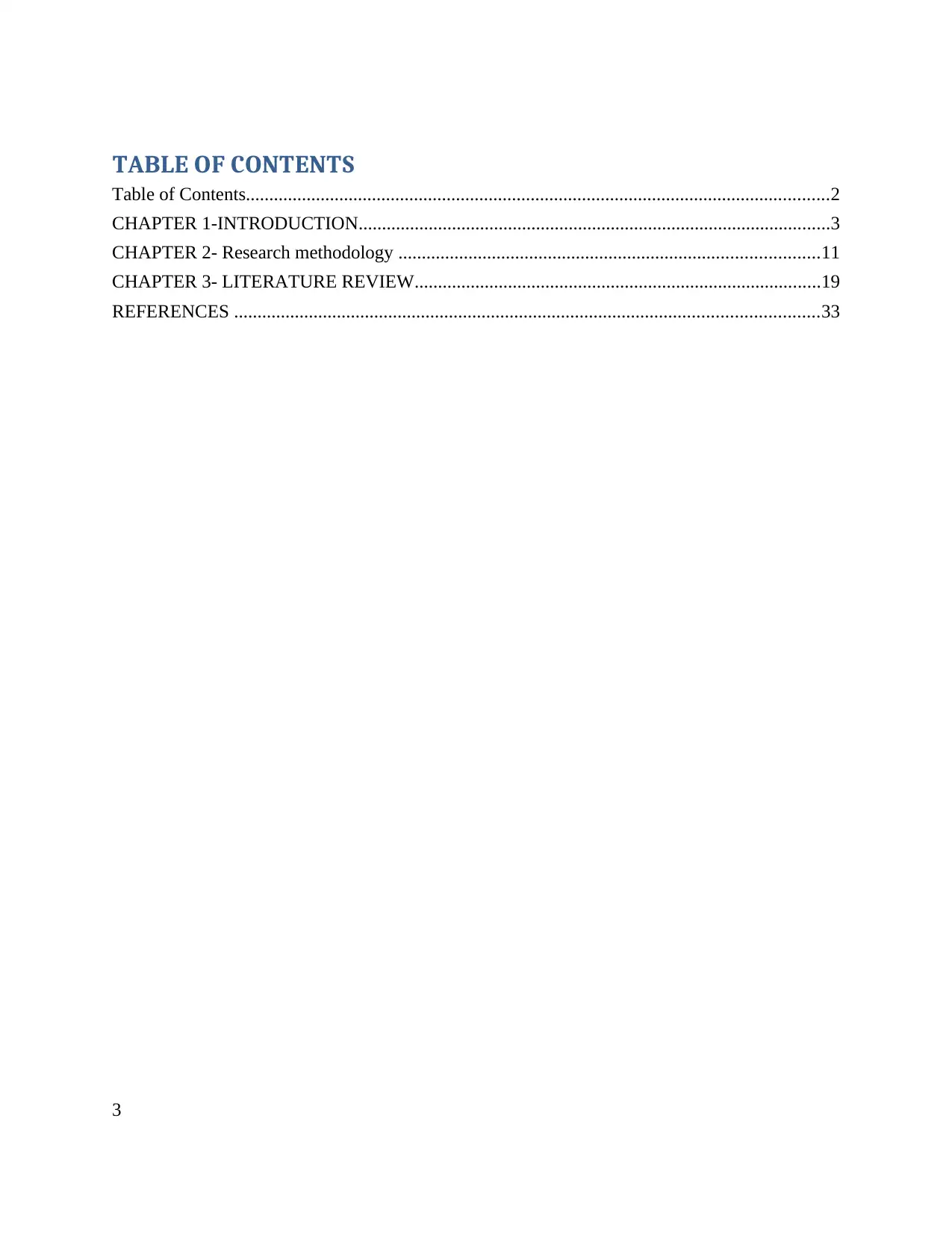
TABLE OF CONTENTS
Table of Contents.............................................................................................................................2
CHAPTER 1-INTRODUCTION.....................................................................................................3
CHAPTER 2- Research methodology ..........................................................................................11
CHAPTER 3- LITERATURE REVIEW.......................................................................................19
REFERENCES .............................................................................................................................33
3
Table of Contents.............................................................................................................................2
CHAPTER 1-INTRODUCTION.....................................................................................................3
CHAPTER 2- Research methodology ..........................................................................................11
CHAPTER 3- LITERATURE REVIEW.......................................................................................19
REFERENCES .............................................................................................................................33
3
⊘ This is a preview!⊘
Do you want full access?
Subscribe today to unlock all pages.

Trusted by 1+ million students worldwide
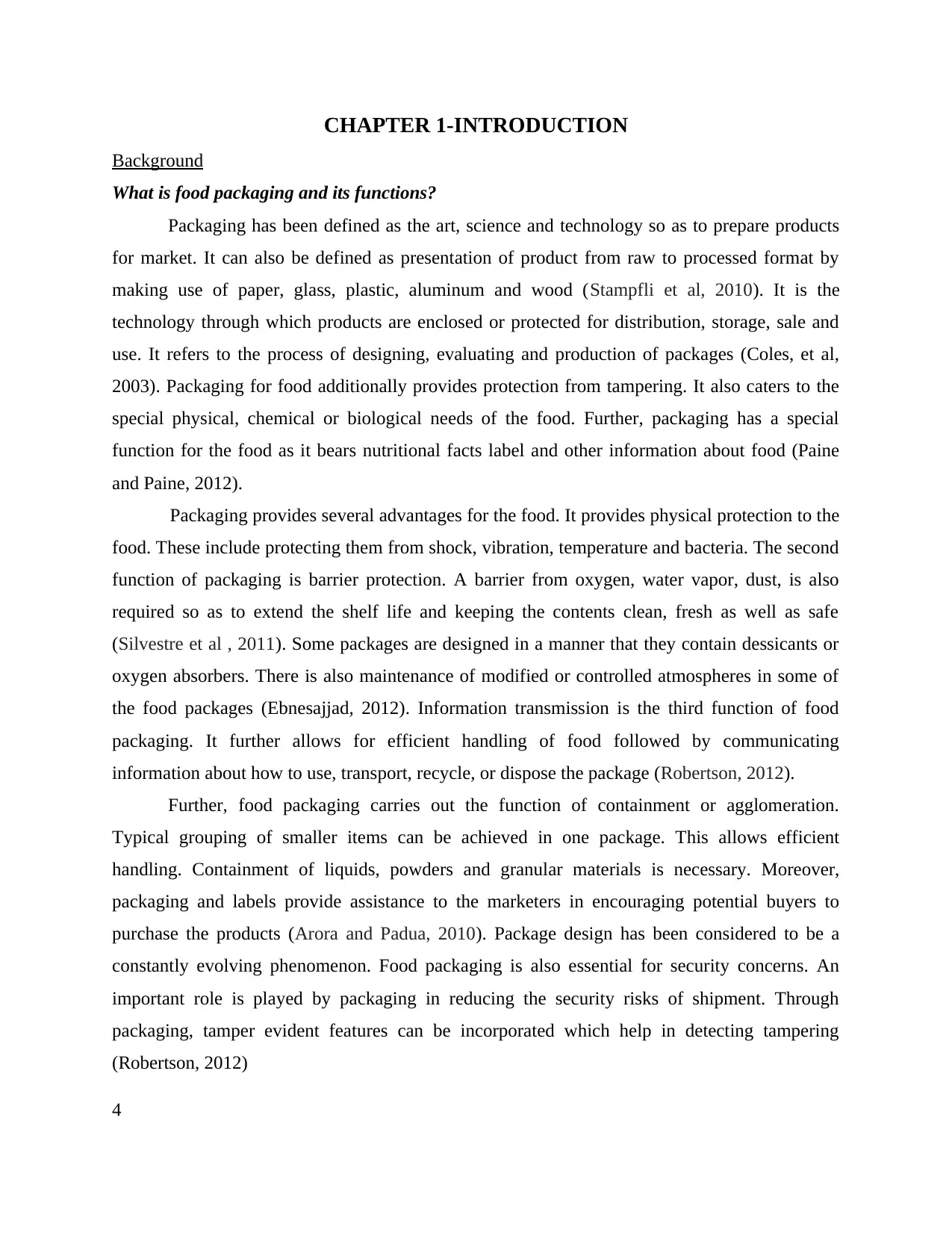
CHAPTER 1-INTRODUCTION
Background
What is food packaging and its functions?
Packaging has been defined as the art, science and technology so as to prepare products
for market. It can also be defined as presentation of product from raw to processed format by
making use of paper, glass, plastic, aluminum and wood (Stampfli et al, 2010). It is the
technology through which products are enclosed or protected for distribution, storage, sale and
use. It refers to the process of designing, evaluating and production of packages (Coles, et al,
2003). Packaging for food additionally provides protection from tampering. It also caters to the
special physical, chemical or biological needs of the food. Further, packaging has a special
function for the food as it bears nutritional facts label and other information about food (Paine
and Paine, 2012).
Packaging provides several advantages for the food. It provides physical protection to the
food. These include protecting them from shock, vibration, temperature and bacteria. The second
function of packaging is barrier protection. A barrier from oxygen, water vapor, dust, is also
required so as to extend the shelf life and keeping the contents clean, fresh as well as safe
(Silvestre et al , 2011). Some packages are designed in a manner that they contain dessicants or
oxygen absorbers. There is also maintenance of modified or controlled atmospheres in some of
the food packages (Ebnesajjad, 2012). Information transmission is the third function of food
packaging. It further allows for efficient handling of food followed by communicating
information about how to use, transport, recycle, or dispose the package (Robertson, 2012).
Further, food packaging carries out the function of containment or agglomeration.
Typical grouping of smaller items can be achieved in one package. This allows efficient
handling. Containment of liquids, powders and granular materials is necessary. Moreover,
packaging and labels provide assistance to the marketers in encouraging potential buyers to
purchase the products (Arora and Padua, 2010). Package design has been considered to be a
constantly evolving phenomenon. Food packaging is also essential for security concerns. An
important role is played by packaging in reducing the security risks of shipment. Through
packaging, tamper evident features can be incorporated which help in detecting tampering
(Robertson, 2012)
4
Background
What is food packaging and its functions?
Packaging has been defined as the art, science and technology so as to prepare products
for market. It can also be defined as presentation of product from raw to processed format by
making use of paper, glass, plastic, aluminum and wood (Stampfli et al, 2010). It is the
technology through which products are enclosed or protected for distribution, storage, sale and
use. It refers to the process of designing, evaluating and production of packages (Coles, et al,
2003). Packaging for food additionally provides protection from tampering. It also caters to the
special physical, chemical or biological needs of the food. Further, packaging has a special
function for the food as it bears nutritional facts label and other information about food (Paine
and Paine, 2012).
Packaging provides several advantages for the food. It provides physical protection to the
food. These include protecting them from shock, vibration, temperature and bacteria. The second
function of packaging is barrier protection. A barrier from oxygen, water vapor, dust, is also
required so as to extend the shelf life and keeping the contents clean, fresh as well as safe
(Silvestre et al , 2011). Some packages are designed in a manner that they contain dessicants or
oxygen absorbers. There is also maintenance of modified or controlled atmospheres in some of
the food packages (Ebnesajjad, 2012). Information transmission is the third function of food
packaging. It further allows for efficient handling of food followed by communicating
information about how to use, transport, recycle, or dispose the package (Robertson, 2012).
Further, food packaging carries out the function of containment or agglomeration.
Typical grouping of smaller items can be achieved in one package. This allows efficient
handling. Containment of liquids, powders and granular materials is necessary. Moreover,
packaging and labels provide assistance to the marketers in encouraging potential buyers to
purchase the products (Arora and Padua, 2010). Package design has been considered to be a
constantly evolving phenomenon. Food packaging is also essential for security concerns. An
important role is played by packaging in reducing the security risks of shipment. Through
packaging, tamper evident features can be incorporated which help in detecting tampering
(Robertson, 2012)
4
Paraphrase This Document
Need a fresh take? Get an instant paraphrase of this document with our AI Paraphraser
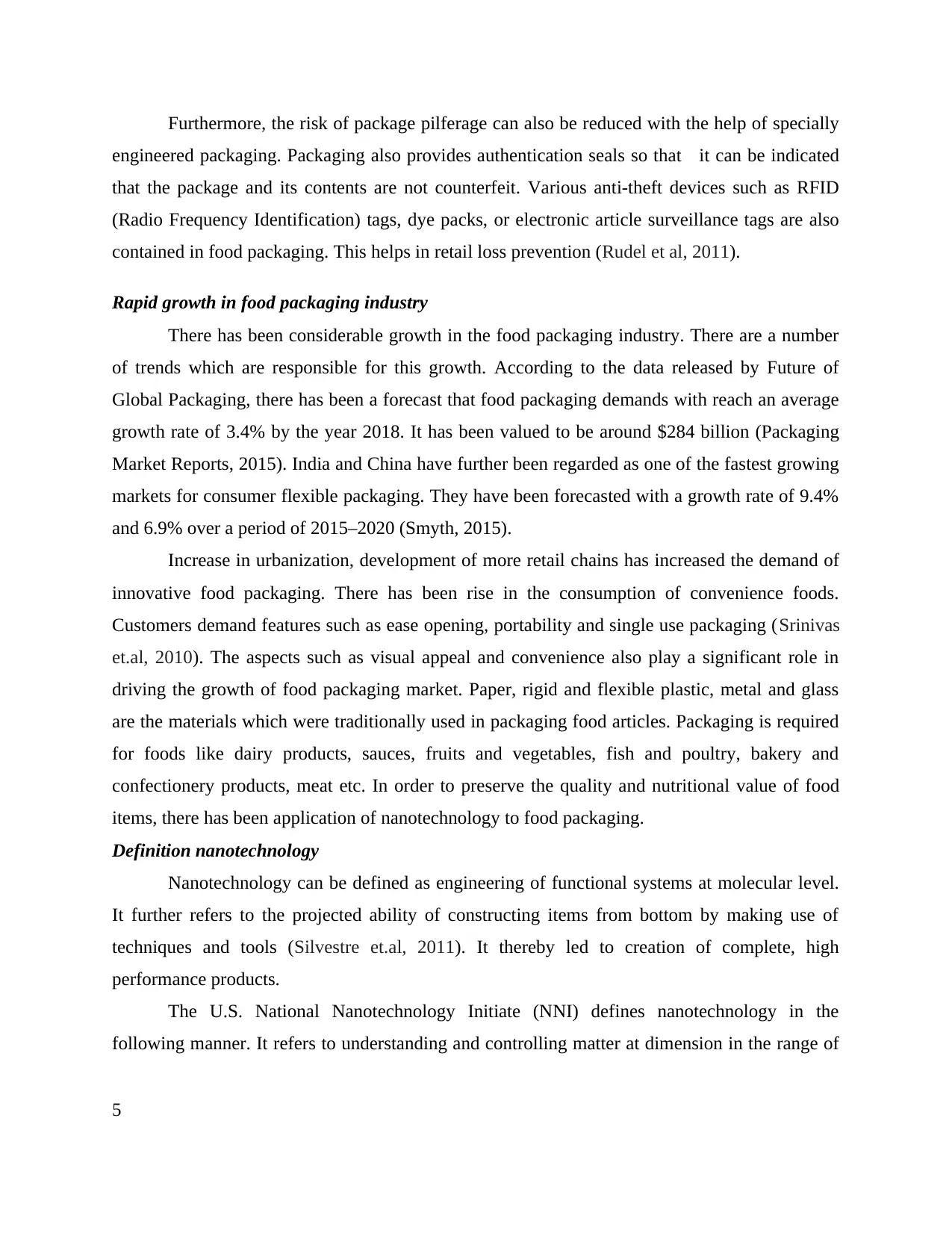
Furthermore, the risk of package pilferage can also be reduced with the help of specially
engineered packaging. Packaging also provides authentication seals so that it can be indicated
that the package and its contents are not counterfeit. Various anti-theft devices such as RFID
(Radio Frequency Identification) tags, dye packs, or electronic article surveillance tags are also
contained in food packaging. This helps in retail loss prevention (Rudel et al, 2011).
Rapid growth in food packaging industry
There has been considerable growth in the food packaging industry. There are a number
of trends which are responsible for this growth. According to the data released by Future of
Global Packaging, there has been a forecast that food packaging demands with reach an average
growth rate of 3.4% by the year 2018. It has been valued to be around $284 billion (Packaging
Market Reports, 2015). India and China have further been regarded as one of the fastest growing
markets for consumer flexible packaging. They have been forecasted with a growth rate of 9.4%
and 6.9% over a period of 2015–2020 (Smyth, 2015).
Increase in urbanization, development of more retail chains has increased the demand of
innovative food packaging. There has been rise in the consumption of convenience foods.
Customers demand features such as ease opening, portability and single use packaging (Srinivas
et.al, 2010). The aspects such as visual appeal and convenience also play a significant role in
driving the growth of food packaging market. Paper, rigid and flexible plastic, metal and glass
are the materials which were traditionally used in packaging food articles. Packaging is required
for foods like dairy products, sauces, fruits and vegetables, fish and poultry, bakery and
confectionery products, meat etc. In order to preserve the quality and nutritional value of food
items, there has been application of nanotechnology to food packaging.
Definition nanotechnology
Nanotechnology can be defined as engineering of functional systems at molecular level.
It further refers to the projected ability of constructing items from bottom by making use of
techniques and tools (Silvestre et.al, 2011). It thereby led to creation of complete, high
performance products.
The U.S. National Nanotechnology Initiate (NNI) defines nanotechnology in the
following manner. It refers to understanding and controlling matter at dimension in the range of
5
engineered packaging. Packaging also provides authentication seals so that it can be indicated
that the package and its contents are not counterfeit. Various anti-theft devices such as RFID
(Radio Frequency Identification) tags, dye packs, or electronic article surveillance tags are also
contained in food packaging. This helps in retail loss prevention (Rudel et al, 2011).
Rapid growth in food packaging industry
There has been considerable growth in the food packaging industry. There are a number
of trends which are responsible for this growth. According to the data released by Future of
Global Packaging, there has been a forecast that food packaging demands with reach an average
growth rate of 3.4% by the year 2018. It has been valued to be around $284 billion (Packaging
Market Reports, 2015). India and China have further been regarded as one of the fastest growing
markets for consumer flexible packaging. They have been forecasted with a growth rate of 9.4%
and 6.9% over a period of 2015–2020 (Smyth, 2015).
Increase in urbanization, development of more retail chains has increased the demand of
innovative food packaging. There has been rise in the consumption of convenience foods.
Customers demand features such as ease opening, portability and single use packaging (Srinivas
et.al, 2010). The aspects such as visual appeal and convenience also play a significant role in
driving the growth of food packaging market. Paper, rigid and flexible plastic, metal and glass
are the materials which were traditionally used in packaging food articles. Packaging is required
for foods like dairy products, sauces, fruits and vegetables, fish and poultry, bakery and
confectionery products, meat etc. In order to preserve the quality and nutritional value of food
items, there has been application of nanotechnology to food packaging.
Definition nanotechnology
Nanotechnology can be defined as engineering of functional systems at molecular level.
It further refers to the projected ability of constructing items from bottom by making use of
techniques and tools (Silvestre et.al, 2011). It thereby led to creation of complete, high
performance products.
The U.S. National Nanotechnology Initiate (NNI) defines nanotechnology in the
following manner. It refers to understanding and controlling matter at dimension in the range of
5
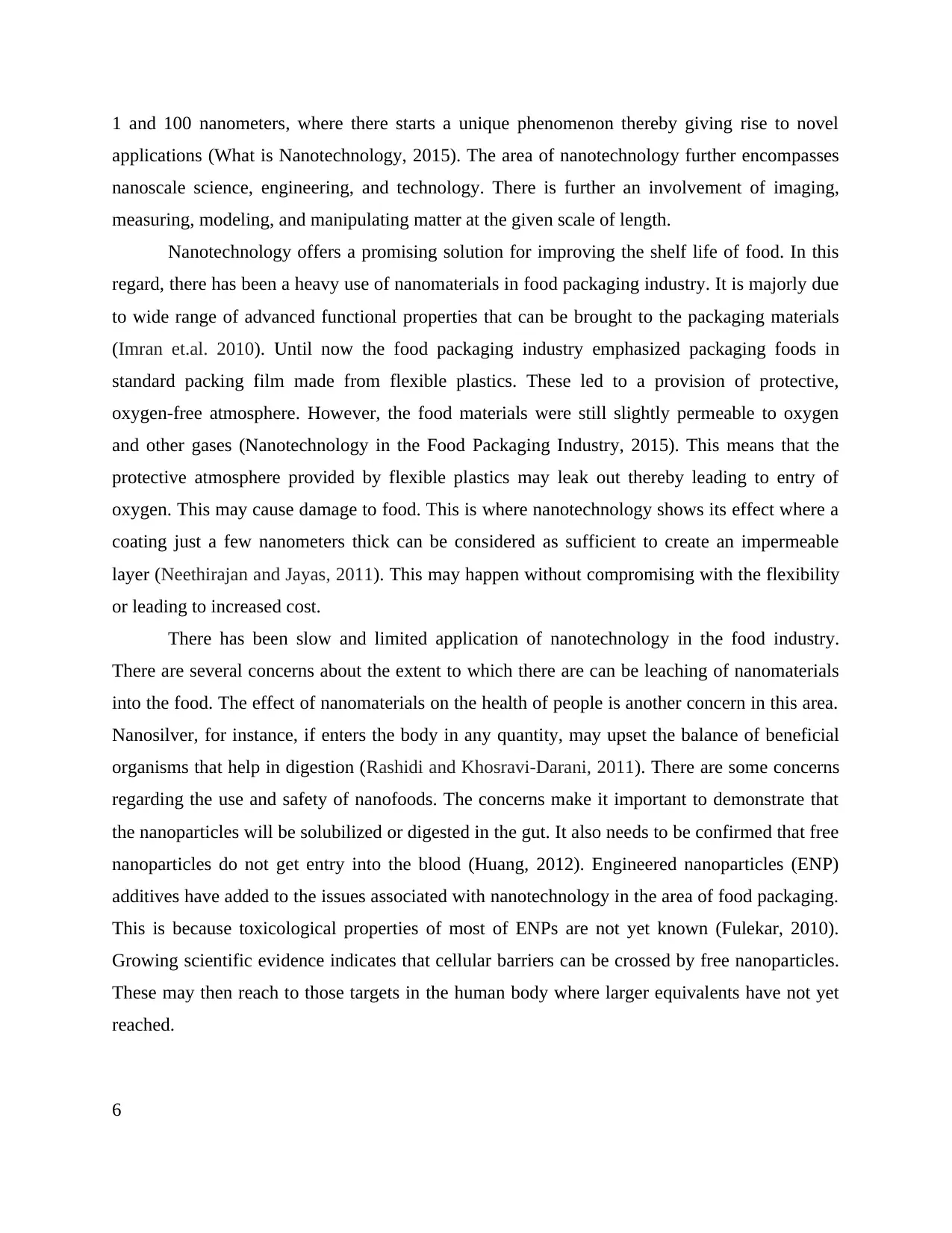
1 and 100 nanometers, where there starts a unique phenomenon thereby giving rise to novel
applications (What is Nanotechnology, 2015). The area of nanotechnology further encompasses
nanoscale science, engineering, and technology. There is further an involvement of imaging,
measuring, modeling, and manipulating matter at the given scale of length.
Nanotechnology offers a promising solution for improving the shelf life of food. In this
regard, there has been a heavy use of nanomaterials in food packaging industry. It is majorly due
to wide range of advanced functional properties that can be brought to the packaging materials
(Imran et.al. 2010). Until now the food packaging industry emphasized packaging foods in
standard packing film made from flexible plastics. These led to a provision of protective,
oxygen-free atmosphere. However, the food materials were still slightly permeable to oxygen
and other gases (Nanotechnology in the Food Packaging Industry, 2015). This means that the
protective atmosphere provided by flexible plastics may leak out thereby leading to entry of
oxygen. This may cause damage to food. This is where nanotechnology shows its effect where a
coating just a few nanometers thick can be considered as sufficient to create an impermeable
layer (Neethirajan and Jayas, 2011). This may happen without compromising with the flexibility
or leading to increased cost.
There has been slow and limited application of nanotechnology in the food industry.
There are several concerns about the extent to which there are can be leaching of nanomaterials
into the food. The effect of nanomaterials on the health of people is another concern in this area.
Nanosilver, for instance, if enters the body in any quantity, may upset the balance of beneficial
organisms that help in digestion (Rashidi and Khosravi-Darani, 2011). There are some concerns
regarding the use and safety of nanofoods. The concerns make it important to demonstrate that
the nanoparticles will be solubilized or digested in the gut. It also needs to be confirmed that free
nanoparticles do not get entry into the blood (Huang, 2012). Engineered nanoparticles (ENP)
additives have added to the issues associated with nanotechnology in the area of food packaging.
This is because toxicological properties of most of ENPs are not yet known (Fulekar, 2010).
Growing scientific evidence indicates that cellular barriers can be crossed by free nanoparticles.
These may then reach to those targets in the human body where larger equivalents have not yet
reached.
6
applications (What is Nanotechnology, 2015). The area of nanotechnology further encompasses
nanoscale science, engineering, and technology. There is further an involvement of imaging,
measuring, modeling, and manipulating matter at the given scale of length.
Nanotechnology offers a promising solution for improving the shelf life of food. In this
regard, there has been a heavy use of nanomaterials in food packaging industry. It is majorly due
to wide range of advanced functional properties that can be brought to the packaging materials
(Imran et.al. 2010). Until now the food packaging industry emphasized packaging foods in
standard packing film made from flexible plastics. These led to a provision of protective,
oxygen-free atmosphere. However, the food materials were still slightly permeable to oxygen
and other gases (Nanotechnology in the Food Packaging Industry, 2015). This means that the
protective atmosphere provided by flexible plastics may leak out thereby leading to entry of
oxygen. This may cause damage to food. This is where nanotechnology shows its effect where a
coating just a few nanometers thick can be considered as sufficient to create an impermeable
layer (Neethirajan and Jayas, 2011). This may happen without compromising with the flexibility
or leading to increased cost.
There has been slow and limited application of nanotechnology in the food industry.
There are several concerns about the extent to which there are can be leaching of nanomaterials
into the food. The effect of nanomaterials on the health of people is another concern in this area.
Nanosilver, for instance, if enters the body in any quantity, may upset the balance of beneficial
organisms that help in digestion (Rashidi and Khosravi-Darani, 2011). There are some concerns
regarding the use and safety of nanofoods. The concerns make it important to demonstrate that
the nanoparticles will be solubilized or digested in the gut. It also needs to be confirmed that free
nanoparticles do not get entry into the blood (Huang, 2012). Engineered nanoparticles (ENP)
additives have added to the issues associated with nanotechnology in the area of food packaging.
This is because toxicological properties of most of ENPs are not yet known (Fulekar, 2010).
Growing scientific evidence indicates that cellular barriers can be crossed by free nanoparticles.
These may then reach to those targets in the human body where larger equivalents have not yet
reached.
6
⊘ This is a preview!⊘
Do you want full access?
Subscribe today to unlock all pages.

Trusted by 1+ million students worldwide
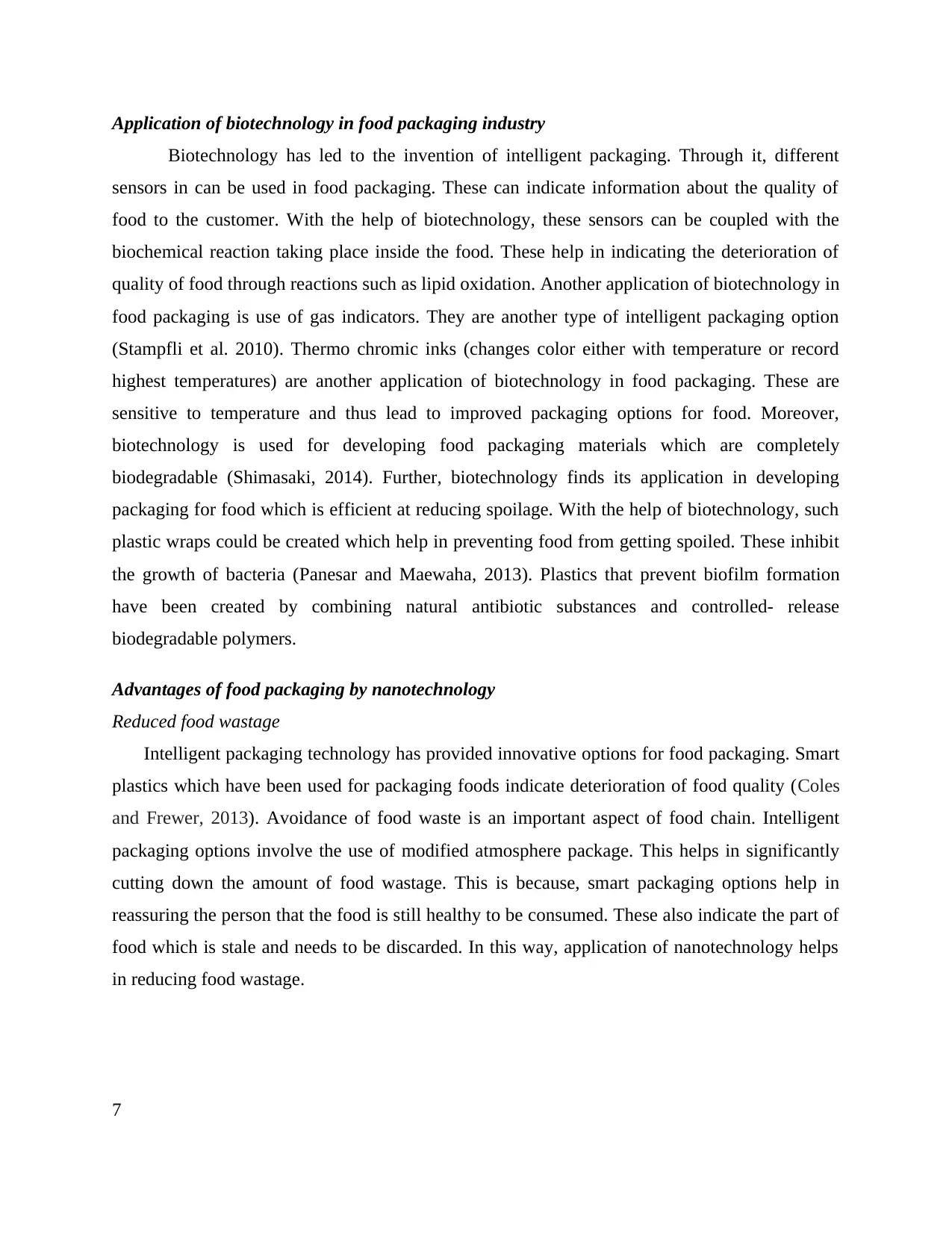
Application of biotechnology in food packaging industry
Biotechnology has led to the invention of intelligent packaging. Through it, different
sensors in can be used in food packaging. These can indicate information about the quality of
food to the customer. With the help of biotechnology, these sensors can be coupled with the
biochemical reaction taking place inside the food. These help in indicating the deterioration of
quality of food through reactions such as lipid oxidation. Another application of biotechnology in
food packaging is use of gas indicators. They are another type of intelligent packaging option
(Stampfli et al. 2010). Thermo chromic inks (changes color either with temperature or record
highest temperatures) are another application of biotechnology in food packaging. These are
sensitive to temperature and thus lead to improved packaging options for food. Moreover,
biotechnology is used for developing food packaging materials which are completely
biodegradable (Shimasaki, 2014). Further, biotechnology finds its application in developing
packaging for food which is efficient at reducing spoilage. With the help of biotechnology, such
plastic wraps could be created which help in preventing food from getting spoiled. These inhibit
the growth of bacteria (Panesar and Maewaha, 2013). Plastics that prevent biofilm formation
have been created by combining natural antibiotic substances and controlled- release
biodegradable polymers.
Advantages of food packaging by nanotechnology
Reduced food wastage
Intelligent packaging technology has provided innovative options for food packaging. Smart
plastics which have been used for packaging foods indicate deterioration of food quality (Coles
and Frewer, 2013). Avoidance of food waste is an important aspect of food chain. Intelligent
packaging options involve the use of modified atmosphere package. This helps in significantly
cutting down the amount of food wastage. This is because, smart packaging options help in
reassuring the person that the food is still healthy to be consumed. These also indicate the part of
food which is stale and needs to be discarded. In this way, application of nanotechnology helps
in reducing food wastage.
7
Biotechnology has led to the invention of intelligent packaging. Through it, different
sensors in can be used in food packaging. These can indicate information about the quality of
food to the customer. With the help of biotechnology, these sensors can be coupled with the
biochemical reaction taking place inside the food. These help in indicating the deterioration of
quality of food through reactions such as lipid oxidation. Another application of biotechnology in
food packaging is use of gas indicators. They are another type of intelligent packaging option
(Stampfli et al. 2010). Thermo chromic inks (changes color either with temperature or record
highest temperatures) are another application of biotechnology in food packaging. These are
sensitive to temperature and thus lead to improved packaging options for food. Moreover,
biotechnology is used for developing food packaging materials which are completely
biodegradable (Shimasaki, 2014). Further, biotechnology finds its application in developing
packaging for food which is efficient at reducing spoilage. With the help of biotechnology, such
plastic wraps could be created which help in preventing food from getting spoiled. These inhibit
the growth of bacteria (Panesar and Maewaha, 2013). Plastics that prevent biofilm formation
have been created by combining natural antibiotic substances and controlled- release
biodegradable polymers.
Advantages of food packaging by nanotechnology
Reduced food wastage
Intelligent packaging technology has provided innovative options for food packaging. Smart
plastics which have been used for packaging foods indicate deterioration of food quality (Coles
and Frewer, 2013). Avoidance of food waste is an important aspect of food chain. Intelligent
packaging options involve the use of modified atmosphere package. This helps in significantly
cutting down the amount of food wastage. This is because, smart packaging options help in
reassuring the person that the food is still healthy to be consumed. These also indicate the part of
food which is stale and needs to be discarded. In this way, application of nanotechnology helps
in reducing food wastage.
7
Paraphrase This Document
Need a fresh take? Get an instant paraphrase of this document with our AI Paraphraser
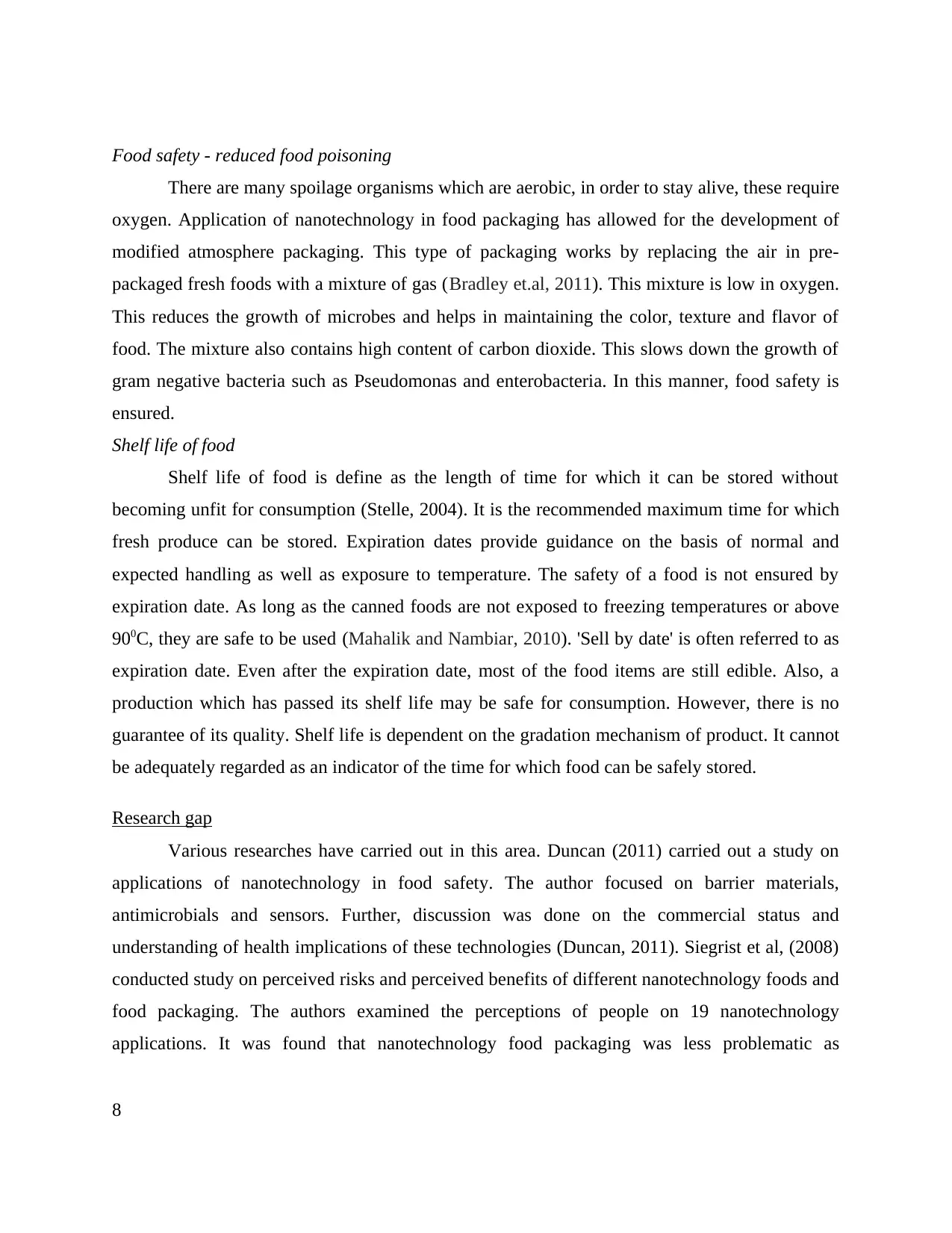
Food safety - reduced food poisoning
There are many spoilage organisms which are aerobic, in order to stay alive, these require
oxygen. Application of nanotechnology in food packaging has allowed for the development of
modified atmosphere packaging. This type of packaging works by replacing the air in pre-
packaged fresh foods with a mixture of gas (Bradley et.al, 2011). This mixture is low in oxygen.
This reduces the growth of microbes and helps in maintaining the color, texture and flavor of
food. The mixture also contains high content of carbon dioxide. This slows down the growth of
gram negative bacteria such as Pseudomonas and enterobacteria. In this manner, food safety is
ensured.
Shelf life of food
Shelf life of food is define as the length of time for which it can be stored without
becoming unfit for consumption (Stelle, 2004). It is the recommended maximum time for which
fresh produce can be stored. Expiration dates provide guidance on the basis of normal and
expected handling as well as exposure to temperature. The safety of a food is not ensured by
expiration date. As long as the canned foods are not exposed to freezing temperatures or above
900C, they are safe to be used (Mahalik and Nambiar, 2010). 'Sell by date' is often referred to as
expiration date. Even after the expiration date, most of the food items are still edible. Also, a
production which has passed its shelf life may be safe for consumption. However, there is no
guarantee of its quality. Shelf life is dependent on the gradation mechanism of product. It cannot
be adequately regarded as an indicator of the time for which food can be safely stored.
Research gap
Various researches have carried out in this area. Duncan (2011) carried out a study on
applications of nanotechnology in food safety. The author focused on barrier materials,
antimicrobials and sensors. Further, discussion was done on the commercial status and
understanding of health implications of these technologies (Duncan, 2011). Siegrist et al, (2008)
conducted study on perceived risks and perceived benefits of different nanotechnology foods and
food packaging. The authors examined the perceptions of people on 19 nanotechnology
applications. It was found that nanotechnology food packaging was less problematic as
8
There are many spoilage organisms which are aerobic, in order to stay alive, these require
oxygen. Application of nanotechnology in food packaging has allowed for the development of
modified atmosphere packaging. This type of packaging works by replacing the air in pre-
packaged fresh foods with a mixture of gas (Bradley et.al, 2011). This mixture is low in oxygen.
This reduces the growth of microbes and helps in maintaining the color, texture and flavor of
food. The mixture also contains high content of carbon dioxide. This slows down the growth of
gram negative bacteria such as Pseudomonas and enterobacteria. In this manner, food safety is
ensured.
Shelf life of food
Shelf life of food is define as the length of time for which it can be stored without
becoming unfit for consumption (Stelle, 2004). It is the recommended maximum time for which
fresh produce can be stored. Expiration dates provide guidance on the basis of normal and
expected handling as well as exposure to temperature. The safety of a food is not ensured by
expiration date. As long as the canned foods are not exposed to freezing temperatures or above
900C, they are safe to be used (Mahalik and Nambiar, 2010). 'Sell by date' is often referred to as
expiration date. Even after the expiration date, most of the food items are still edible. Also, a
production which has passed its shelf life may be safe for consumption. However, there is no
guarantee of its quality. Shelf life is dependent on the gradation mechanism of product. It cannot
be adequately regarded as an indicator of the time for which food can be safely stored.
Research gap
Various researches have carried out in this area. Duncan (2011) carried out a study on
applications of nanotechnology in food safety. The author focused on barrier materials,
antimicrobials and sensors. Further, discussion was done on the commercial status and
understanding of health implications of these technologies (Duncan, 2011). Siegrist et al, (2008)
conducted study on perceived risks and perceived benefits of different nanotechnology foods and
food packaging. The authors examined the perceptions of people on 19 nanotechnology
applications. It was found that nanotechnology food packaging was less problematic as
8
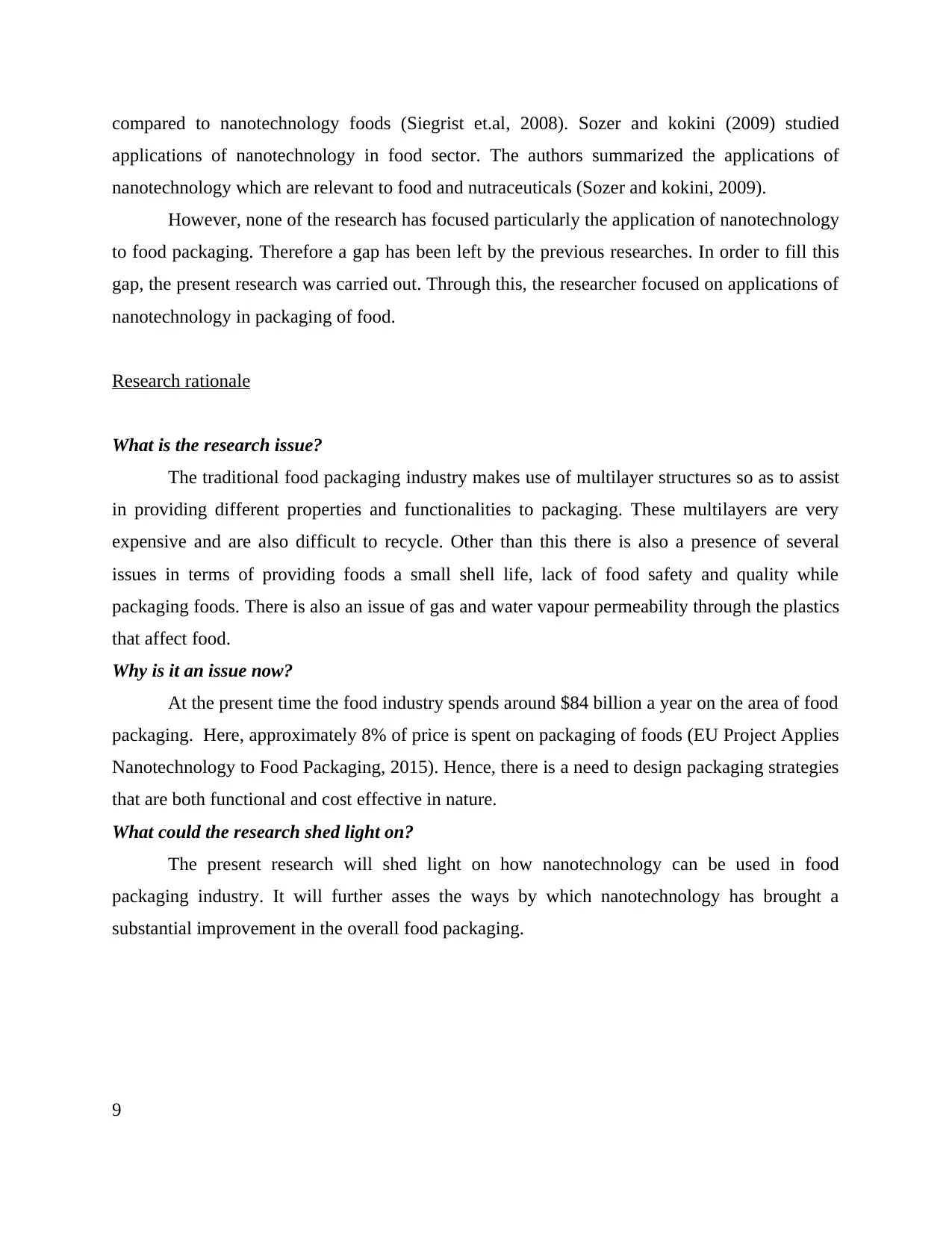
compared to nanotechnology foods (Siegrist et.al, 2008). Sozer and kokini (2009) studied
applications of nanotechnology in food sector. The authors summarized the applications of
nanotechnology which are relevant to food and nutraceuticals (Sozer and kokini, 2009).
However, none of the research has focused particularly the application of nanotechnology
to food packaging. Therefore a gap has been left by the previous researches. In order to fill this
gap, the present research was carried out. Through this, the researcher focused on applications of
nanotechnology in packaging of food.
Research rationale
What is the research issue?
The traditional food packaging industry makes use of multilayer structures so as to assist
in providing different properties and functionalities to packaging. These multilayers are very
expensive and are also difficult to recycle. Other than this there is also a presence of several
issues in terms of providing foods a small shell life, lack of food safety and quality while
packaging foods. There is also an issue of gas and water vapour permeability through the plastics
that affect food.
Why is it an issue now?
At the present time the food industry spends around $84 billion a year on the area of food
packaging. Here, approximately 8% of price is spent on packaging of foods (EU Project Applies
Nanotechnology to Food Packaging, 2015). Hence, there is a need to design packaging strategies
that are both functional and cost effective in nature.
What could the research shed light on?
The present research will shed light on how nanotechnology can be used in food
packaging industry. It will further asses the ways by which nanotechnology has brought a
substantial improvement in the overall food packaging.
9
applications of nanotechnology in food sector. The authors summarized the applications of
nanotechnology which are relevant to food and nutraceuticals (Sozer and kokini, 2009).
However, none of the research has focused particularly the application of nanotechnology
to food packaging. Therefore a gap has been left by the previous researches. In order to fill this
gap, the present research was carried out. Through this, the researcher focused on applications of
nanotechnology in packaging of food.
Research rationale
What is the research issue?
The traditional food packaging industry makes use of multilayer structures so as to assist
in providing different properties and functionalities to packaging. These multilayers are very
expensive and are also difficult to recycle. Other than this there is also a presence of several
issues in terms of providing foods a small shell life, lack of food safety and quality while
packaging foods. There is also an issue of gas and water vapour permeability through the plastics
that affect food.
Why is it an issue now?
At the present time the food industry spends around $84 billion a year on the area of food
packaging. Here, approximately 8% of price is spent on packaging of foods (EU Project Applies
Nanotechnology to Food Packaging, 2015). Hence, there is a need to design packaging strategies
that are both functional and cost effective in nature.
What could the research shed light on?
The present research will shed light on how nanotechnology can be used in food
packaging industry. It will further asses the ways by which nanotechnology has brought a
substantial improvement in the overall food packaging.
9
⊘ This is a preview!⊘
Do you want full access?
Subscribe today to unlock all pages.

Trusted by 1+ million students worldwide
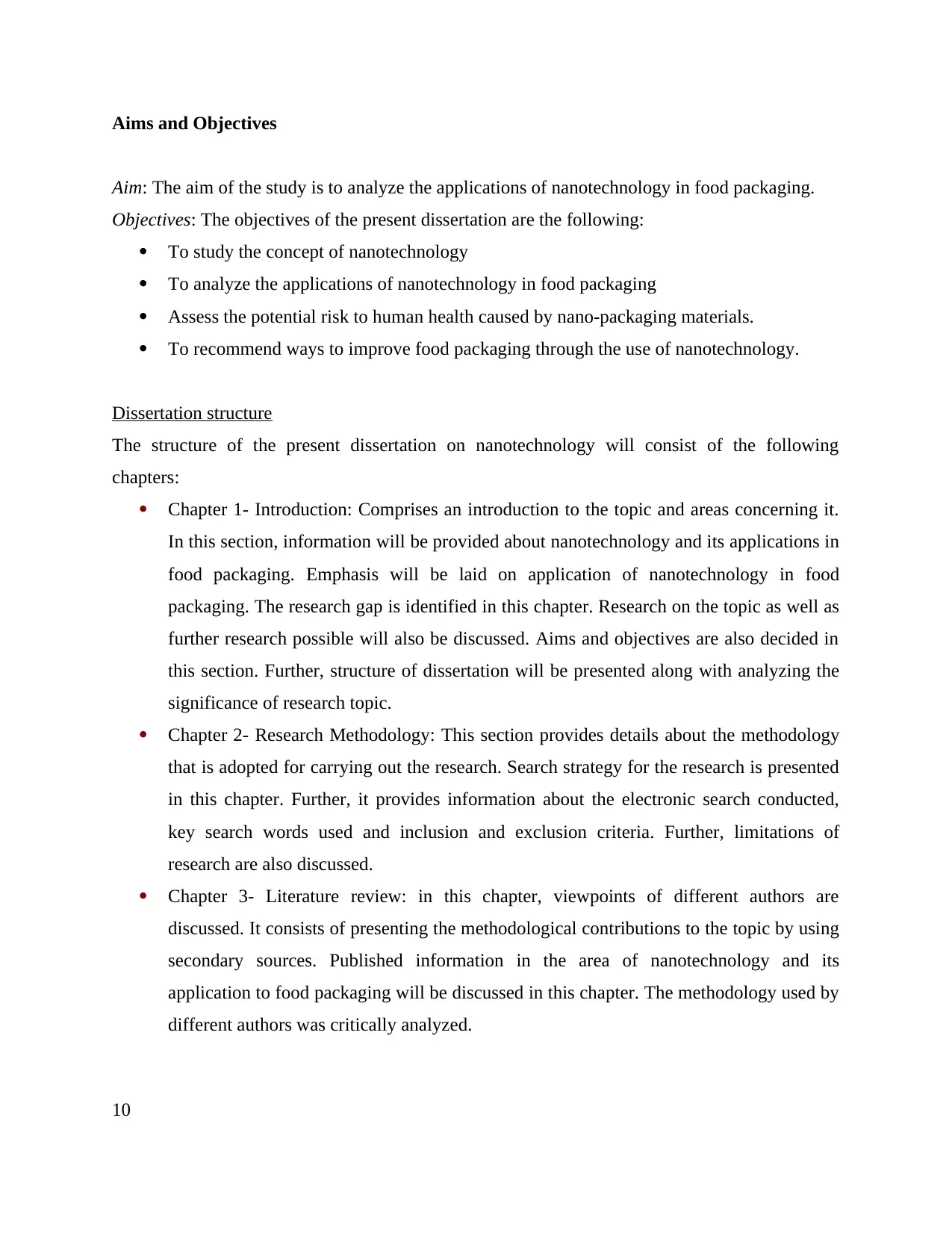
Aims and Objectives
Aim: The aim of the study is to analyze the applications of nanotechnology in food packaging.
Objectives: The objectives of the present dissertation are the following:
To study the concept of nanotechnology
To analyze the applications of nanotechnology in food packaging
Assess the potential risk to human health caused by nano-packaging materials.
To recommend ways to improve food packaging through the use of nanotechnology.
Dissertation structure
The structure of the present dissertation on nanotechnology will consist of the following
chapters:
Chapter 1- Introduction: Comprises an introduction to the topic and areas concerning it.
In this section, information will be provided about nanotechnology and its applications in
food packaging. Emphasis will be laid on application of nanotechnology in food
packaging. The research gap is identified in this chapter. Research on the topic as well as
further research possible will also be discussed. Aims and objectives are also decided in
this section. Further, structure of dissertation will be presented along with analyzing the
significance of research topic.
Chapter 2- Research Methodology: This section provides details about the methodology
that is adopted for carrying out the research. Search strategy for the research is presented
in this chapter. Further, it provides information about the electronic search conducted,
key search words used and inclusion and exclusion criteria. Further, limitations of
research are also discussed.
Chapter 3- Literature review: in this chapter, viewpoints of different authors are
discussed. It consists of presenting the methodological contributions to the topic by using
secondary sources. Published information in the area of nanotechnology and its
application to food packaging will be discussed in this chapter. The methodology used by
different authors was critically analyzed.
10
Aim: The aim of the study is to analyze the applications of nanotechnology in food packaging.
Objectives: The objectives of the present dissertation are the following:
To study the concept of nanotechnology
To analyze the applications of nanotechnology in food packaging
Assess the potential risk to human health caused by nano-packaging materials.
To recommend ways to improve food packaging through the use of nanotechnology.
Dissertation structure
The structure of the present dissertation on nanotechnology will consist of the following
chapters:
Chapter 1- Introduction: Comprises an introduction to the topic and areas concerning it.
In this section, information will be provided about nanotechnology and its applications in
food packaging. Emphasis will be laid on application of nanotechnology in food
packaging. The research gap is identified in this chapter. Research on the topic as well as
further research possible will also be discussed. Aims and objectives are also decided in
this section. Further, structure of dissertation will be presented along with analyzing the
significance of research topic.
Chapter 2- Research Methodology: This section provides details about the methodology
that is adopted for carrying out the research. Search strategy for the research is presented
in this chapter. Further, it provides information about the electronic search conducted,
key search words used and inclusion and exclusion criteria. Further, limitations of
research are also discussed.
Chapter 3- Literature review: in this chapter, viewpoints of different authors are
discussed. It consists of presenting the methodological contributions to the topic by using
secondary sources. Published information in the area of nanotechnology and its
application to food packaging will be discussed in this chapter. The methodology used by
different authors was critically analyzed.
10
Paraphrase This Document
Need a fresh take? Get an instant paraphrase of this document with our AI Paraphraser
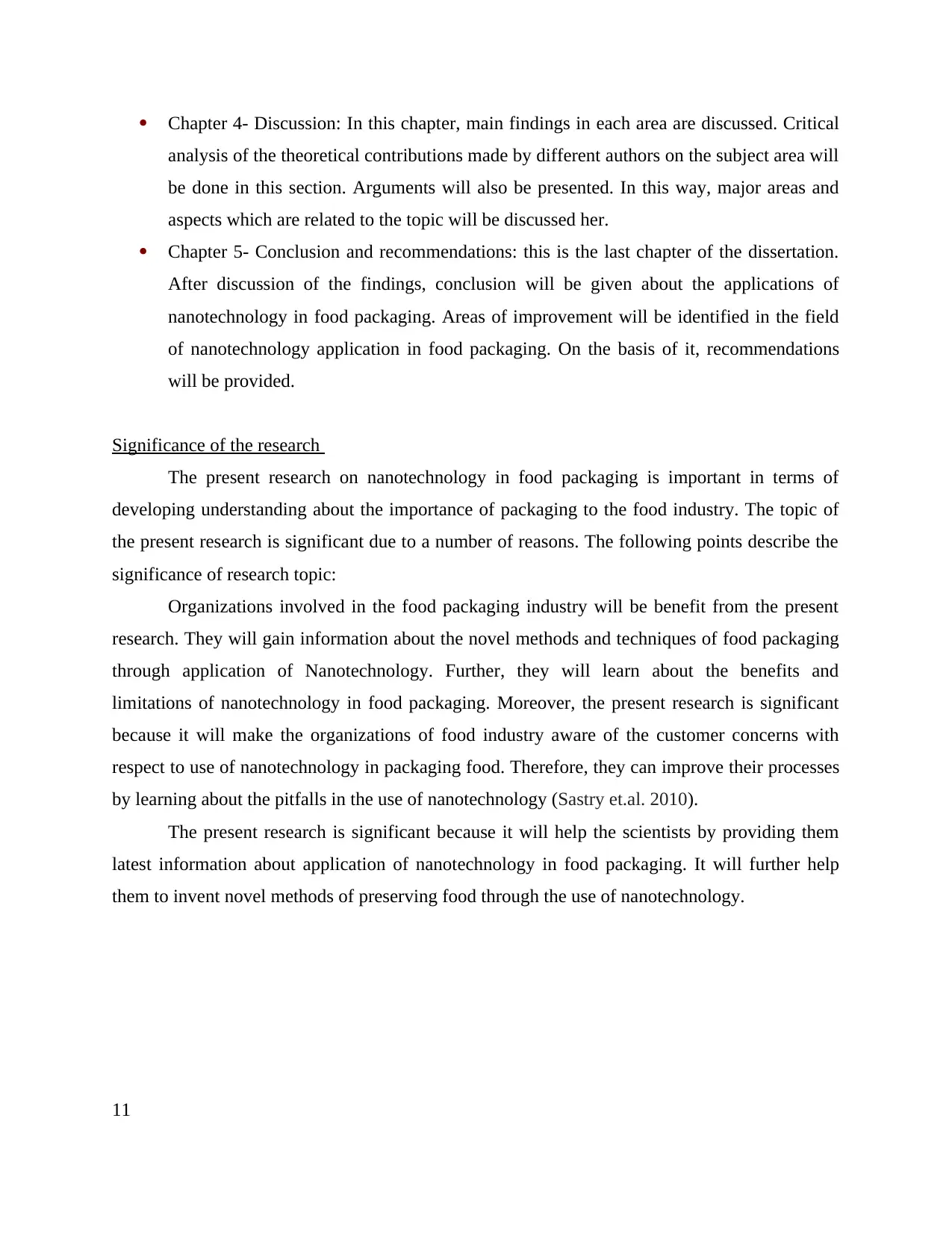
Chapter 4- Discussion: In this chapter, main findings in each area are discussed. Critical
analysis of the theoretical contributions made by different authors on the subject area will
be done in this section. Arguments will also be presented. In this way, major areas and
aspects which are related to the topic will be discussed her.
Chapter 5- Conclusion and recommendations: this is the last chapter of the dissertation.
After discussion of the findings, conclusion will be given about the applications of
nanotechnology in food packaging. Areas of improvement will be identified in the field
of nanotechnology application in food packaging. On the basis of it, recommendations
will be provided.
Significance of the research
The present research on nanotechnology in food packaging is important in terms of
developing understanding about the importance of packaging to the food industry. The topic of
the present research is significant due to a number of reasons. The following points describe the
significance of research topic:
Organizations involved in the food packaging industry will be benefit from the present
research. They will gain information about the novel methods and techniques of food packaging
through application of Nanotechnology. Further, they will learn about the benefits and
limitations of nanotechnology in food packaging. Moreover, the present research is significant
because it will make the organizations of food industry aware of the customer concerns with
respect to use of nanotechnology in packaging food. Therefore, they can improve their processes
by learning about the pitfalls in the use of nanotechnology (Sastry et.al. 2010).
The present research is significant because it will help the scientists by providing them
latest information about application of nanotechnology in food packaging. It will further help
them to invent novel methods of preserving food through the use of nanotechnology.
11
analysis of the theoretical contributions made by different authors on the subject area will
be done in this section. Arguments will also be presented. In this way, major areas and
aspects which are related to the topic will be discussed her.
Chapter 5- Conclusion and recommendations: this is the last chapter of the dissertation.
After discussion of the findings, conclusion will be given about the applications of
nanotechnology in food packaging. Areas of improvement will be identified in the field
of nanotechnology application in food packaging. On the basis of it, recommendations
will be provided.
Significance of the research
The present research on nanotechnology in food packaging is important in terms of
developing understanding about the importance of packaging to the food industry. The topic of
the present research is significant due to a number of reasons. The following points describe the
significance of research topic:
Organizations involved in the food packaging industry will be benefit from the present
research. They will gain information about the novel methods and techniques of food packaging
through application of Nanotechnology. Further, they will learn about the benefits and
limitations of nanotechnology in food packaging. Moreover, the present research is significant
because it will make the organizations of food industry aware of the customer concerns with
respect to use of nanotechnology in packaging food. Therefore, they can improve their processes
by learning about the pitfalls in the use of nanotechnology (Sastry et.al. 2010).
The present research is significant because it will help the scientists by providing them
latest information about application of nanotechnology in food packaging. It will further help
them to invent novel methods of preserving food through the use of nanotechnology.
11
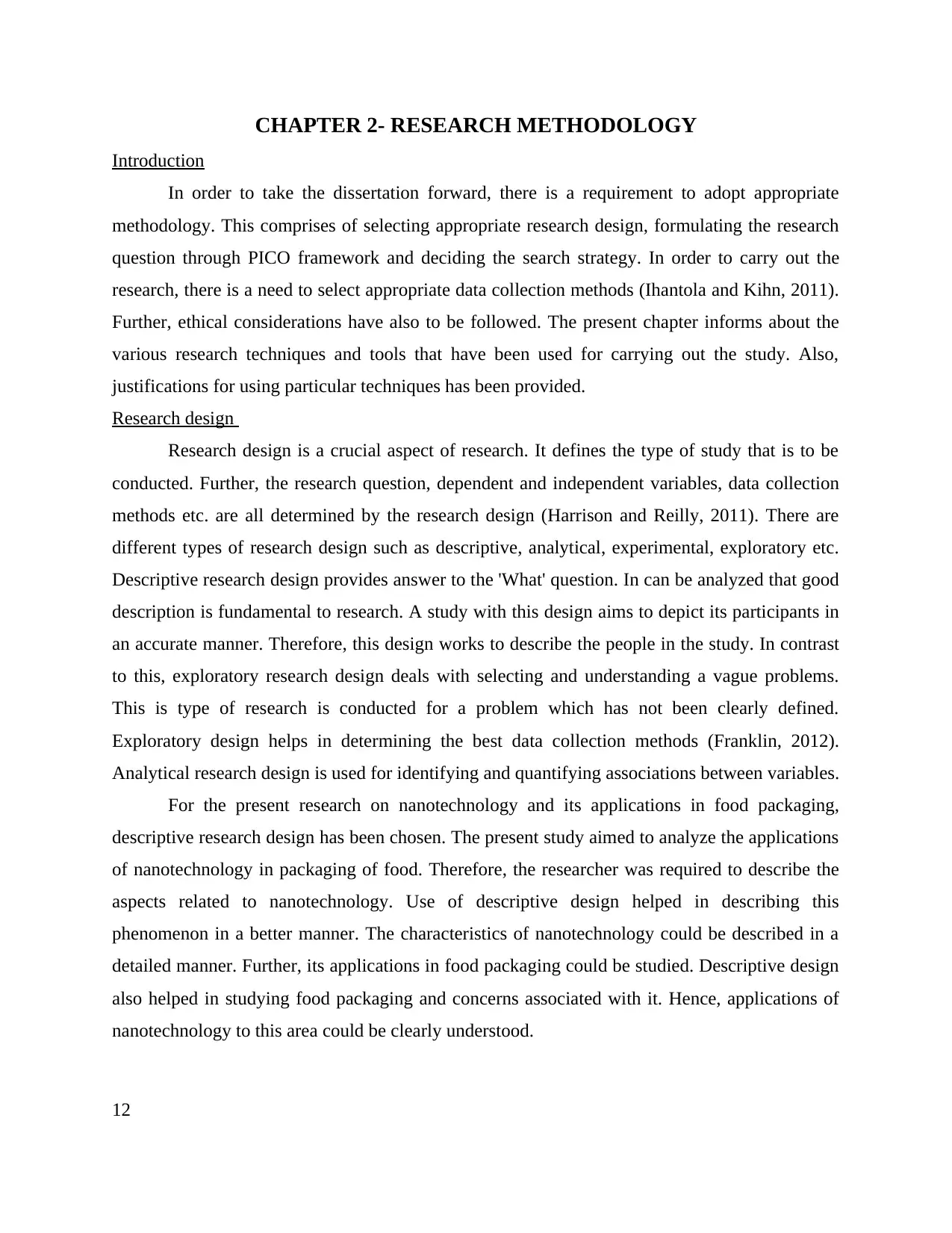
CHAPTER 2- RESEARCH METHODOLOGY
Introduction
In order to take the dissertation forward, there is a requirement to adopt appropriate
methodology. This comprises of selecting appropriate research design, formulating the research
question through PICO framework and deciding the search strategy. In order to carry out the
research, there is a need to select appropriate data collection methods (Ihantola and Kihn, 2011).
Further, ethical considerations have also to be followed. The present chapter informs about the
various research techniques and tools that have been used for carrying out the study. Also,
justifications for using particular techniques has been provided.
Research design
Research design is a crucial aspect of research. It defines the type of study that is to be
conducted. Further, the research question, dependent and independent variables, data collection
methods etc. are all determined by the research design (Harrison and Reilly, 2011). There are
different types of research design such as descriptive, analytical, experimental, exploratory etc.
Descriptive research design provides answer to the 'What' question. In can be analyzed that good
description is fundamental to research. A study with this design aims to depict its participants in
an accurate manner. Therefore, this design works to describe the people in the study. In contrast
to this, exploratory research design deals with selecting and understanding a vague problems.
This is type of research is conducted for a problem which has not been clearly defined.
Exploratory design helps in determining the best data collection methods (Franklin, 2012).
Analytical research design is used for identifying and quantifying associations between variables.
For the present research on nanotechnology and its applications in food packaging,
descriptive research design has been chosen. The present study aimed to analyze the applications
of nanotechnology in packaging of food. Therefore, the researcher was required to describe the
aspects related to nanotechnology. Use of descriptive design helped in describing this
phenomenon in a better manner. The characteristics of nanotechnology could be described in a
detailed manner. Further, its applications in food packaging could be studied. Descriptive design
also helped in studying food packaging and concerns associated with it. Hence, applications of
nanotechnology to this area could be clearly understood.
12
Introduction
In order to take the dissertation forward, there is a requirement to adopt appropriate
methodology. This comprises of selecting appropriate research design, formulating the research
question through PICO framework and deciding the search strategy. In order to carry out the
research, there is a need to select appropriate data collection methods (Ihantola and Kihn, 2011).
Further, ethical considerations have also to be followed. The present chapter informs about the
various research techniques and tools that have been used for carrying out the study. Also,
justifications for using particular techniques has been provided.
Research design
Research design is a crucial aspect of research. It defines the type of study that is to be
conducted. Further, the research question, dependent and independent variables, data collection
methods etc. are all determined by the research design (Harrison and Reilly, 2011). There are
different types of research design such as descriptive, analytical, experimental, exploratory etc.
Descriptive research design provides answer to the 'What' question. In can be analyzed that good
description is fundamental to research. A study with this design aims to depict its participants in
an accurate manner. Therefore, this design works to describe the people in the study. In contrast
to this, exploratory research design deals with selecting and understanding a vague problems.
This is type of research is conducted for a problem which has not been clearly defined.
Exploratory design helps in determining the best data collection methods (Franklin, 2012).
Analytical research design is used for identifying and quantifying associations between variables.
For the present research on nanotechnology and its applications in food packaging,
descriptive research design has been chosen. The present study aimed to analyze the applications
of nanotechnology in packaging of food. Therefore, the researcher was required to describe the
aspects related to nanotechnology. Use of descriptive design helped in describing this
phenomenon in a better manner. The characteristics of nanotechnology could be described in a
detailed manner. Further, its applications in food packaging could be studied. Descriptive design
also helped in studying food packaging and concerns associated with it. Hence, applications of
nanotechnology to this area could be clearly understood.
12
⊘ This is a preview!⊘
Do you want full access?
Subscribe today to unlock all pages.

Trusted by 1+ million students worldwide
1 out of 50
Your All-in-One AI-Powered Toolkit for Academic Success.
+13062052269
info@desklib.com
Available 24*7 on WhatsApp / Email
![[object Object]](/_next/static/media/star-bottom.7253800d.svg)
Unlock your academic potential
Copyright © 2020–2025 A2Z Services. All Rights Reserved. Developed and managed by ZUCOL.


